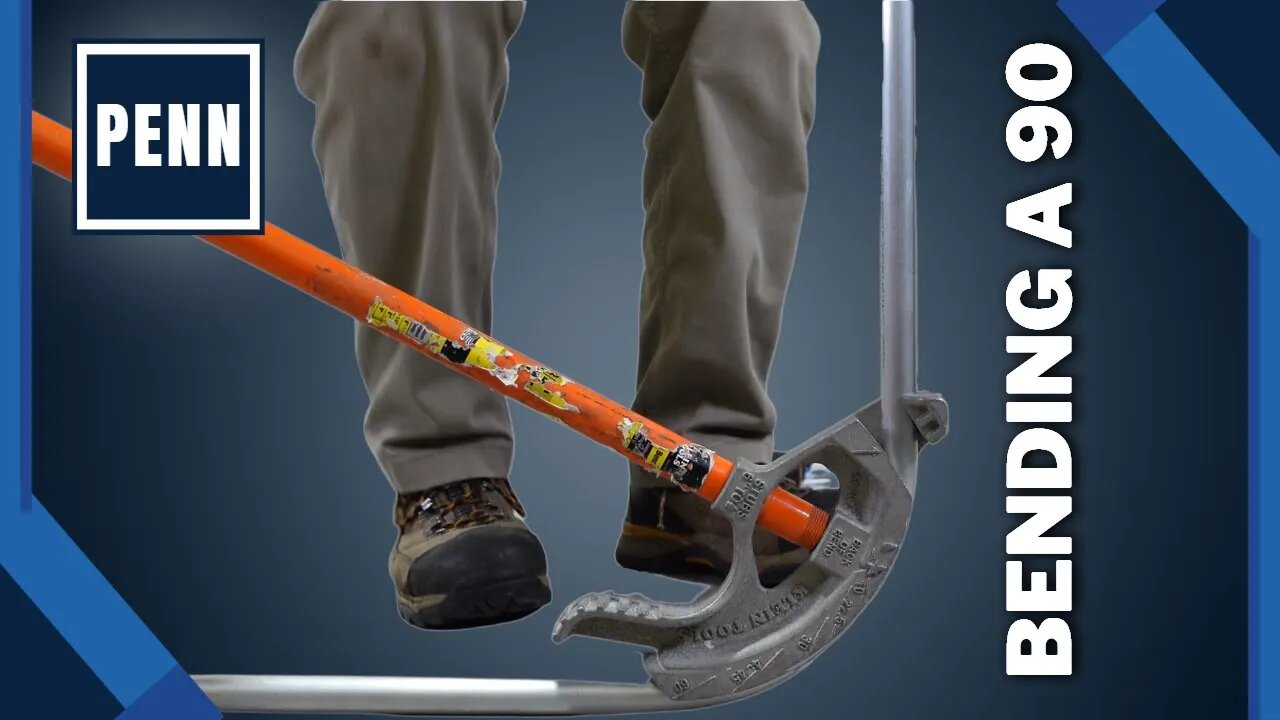Premium Only Content

How Do You Bend a 90 in Conduit?
Join this channel to get access to perks:
https://www.youtube.com/channel/UCB3jUEyCLRbCw7QED0vnXYg/join
⚡🔨SPONSOR: PENN ALUMINUM🔨⚡
https://www.pennconduit.com/
Installing conduit is one of the primary tasks of a commercial/industrial electrician. Without it, wire can’t get from one point to another! And bending a 90 degree bend in conduit is one of the first skills learned when starting to bend conduit. Most of us electricians start out learning to bend on steel EMT conduit. But what about Aluminum EMT conduit? Is there a difference? In todays episode of Electrician U, Dustin Stelzer talks a bit about the pros and cons of each as well as the necessary steps to successfully bending a 90-degree bend.
🤘⚡️MEMBERSHIP⚡️🤘
JOIN ELECTRICIAN U - become a member and get:
FREE Continuing Education every year
FREE Practice Exams
FREE Monthly Video Courses
FREE Weekly Live Instructor-Led Classes
FREE Monthly Educational Newsletter
Premium Members-Only Content
Private Discord Channel
Monthly Members-Only Discord Chats
Sign up here --- https://www.electricianu.com/electrician-u-membership/
🎧🎹MUSIC AND VIDEO:🎹🎧
https://www.facebook.com/descantmv
🎬✍️ART AND ILLUSTRATION:✍️🎬
https://www.daverussoart.com
First let’s talk about Penn Aluminum, todays sponsor. Penn Aluminum produces some of the best Aluminum EMT conduit available. But why use aluminum EMT instead of steel? Its considerably lighter than its steel counterpart and easier to bend, which results in much less stress on the installing electrician and leads to much greater productivity. In todays market, aluminum EMT conduit is anywhere from 10% to 20% cheaper than steel EMT, which can add considerable cost SAVINGS to a project. However, one of the downfalls to using aluminum EMT is that it IS harder to pull wire into. It just seems that the wire (or the wire pulling apparatus) gets hung up on the inside of the pipe. Penn Aluminum has developed a special coating for the inside of the conduit called Blue Lightning. This coating acts much like Teflon making the inside of the pipe super slick and wire goes in much easier even than standard steel EMT. Check out Penn Aluminums website- they have a ton of products that will certainly meet your conduit needs! Great company!
The first step in bending a 90 in conduit is to establish a length. Once a length is established, you will need to mark this on the conduit- lets say 36”. The next step in the process is to apply the deduct (this is the length required where the conduit will actually SWEEP and that will need to be considered in our calculation). Standard deducts are ½”- 5”, ¾”- 6”, 1”- 8”. Subtract this distance from your original mark- for our 36” 90, we will make another mark on our conduit at 30”. Hook the bender onto the conduit with the open end of the bender FACING the direction you hooked your tape measure on. Place the ARROW on the bender handle on the 30” mark (distance needed for 90 MINUS the DEDUCT). A very important step in the bending process is to apply FOOT pressure, not just PULL with your arms. So, step on the bender shoe, while pulling on the bender handle until the measured portion of the conduit is vertical in the air. Using a torpedo level, continue to adjust the vertical portion until it is at 90 degrees. That’s it! Bend completed! Not to worry if you OVERBEND, just step on the portion of the conduit still on the ground and PUSH the vertical portion of the conduit AWAY from you until it is at 90 degrees.
A variation of this bend technique can be used. There is a star marking on the bender shoe that signifies the BACK of a 90-degree bend. If you had a longer 90 degree needed- say 8’ in lieu of our 36” mentioned earlier, make your initial measurement, turn the bender around and hook it on the conduit facing AWAY from the side you measured from, place the STAR on your mark, and then bend the conduit as normal! This keeps you from having the short part of the EMT on the ground and 8’ of pipe flailing around in the air!!
A few tips- use a PENCIL to make marks on conduit and erase them once the bend is completed. It just looks better! Also, carry a level with you so your bends are accurate. Use constant foot pressure (don’t just pull with your arms) so your bends don’t kink. If you are having trouble with the conduit sliding around on you, consider putting your tool pouches on your hips to add some weight and/or put the long end of the conduit on the ground up against something non moveable (a wall for example) so it won’t slide.
We hope this has been an informative look into Aluminum EMT conduit and 90 bending techniques. Is there a topic you would like to see discussed on Electrician U? Leave a comment in the comments section and let us know. Please continue to follow Dustin and Electrician U as we are constantly updating our content to assist our followers in becoming the best electricians that they can be.
-
 0:56
0:56
Electrician U
1 year ago90° Drill Attachment!!! - What Hand Tools Are YOU Missing
5.68K1 -
 20:40
20:40
Side Scrollers Podcast
13 hours agoGen Z Tries OG Super Mario Bros for the First Time
9.69K2 -
 LIVE
LIVE
Spartan
3 hours agoPro Halo Player | Ranked + SWTOR
116 watching -
 1:34:00
1:34:00
Nick Freitas
5 hours agoCan Elon Musk’s America Party Actually Win?
31.6K14 -
 2:37:04
2:37:04
megimu32
3 hours agoOTS: The Matrix Was About WHAT?! Trans Allegory, Cancel Culture & Comedic Chaos
11.2K7 -
 LIVE
LIVE
VapinGamers
3 hours ago $0.01 earnedDestiny 2 - Just Cause and Goodies, Let's Talk New Stuff - !rumbot !music
309 watching -
![Batman Arkham Knight [6K Reshade Mods] Hardest Difficulty ⋆ Western Retread](https://1a-1791.com/video/fww1/4a/s8/1/M/p/x/0/Mpx0y.0kob.1-small-Batman-Arkham-Knight-6K-Res.jpg) LIVE
LIVE
FusedAegisTV
9 hours agoBatman Arkham Knight [6K Reshade Mods] Hardest Difficulty ⋆ Western Retread
54 watching -
 31:35
31:35
Solar Groove Muzic
1 day ago $0.01 earnedDeep House Mix 2025 | Deep House, Vocal House, Nu Disco, Chillout
8.99K2 -
 1:21:31
1:21:31
Glenn Greenwald
6 hours agoTrump Mocks Concerns About Epstein; Trump Continues Biden's Policy of Arming Ukraine; Trump and Lula Exchange Barbs Over Brazil | SYSTEM UPDATE #483
117K120 -
 54:26
54:26
Edge of Wonder
9 hours agoTexas Floods: Boots on the Ground with Shawn Livingston
26.1K8